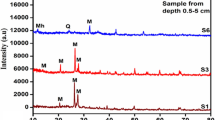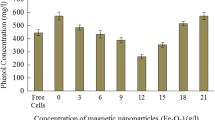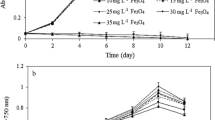Abstract
Bioremediation of toxic metals by magnetotactic bacteria and magnetic separation of metal-loaded magnetotactic bacteria are of great interest. This bioprocess technique is rapid, efficient, economical, and environmentally friendly. In this study, cobalt removal potential of a novel isolated magnetotactic bacterium (Alphaproteobacterium MTB-KTN90) as a new biosorbent was investigated. The effects of various environmental parameters in the cobalt removal and the technique of magnetic separation of cobalt-loaded bacterial cells were studied. Cobalt removal by MTB-KTN90 was very sensitive to pH solution; higher biosorption capacity was observed around pH 6.5–7.0. When biomass concentration increased from 0.009 to 0.09 g/l, the biosorption efficiency increased from 13.87 % to 19.22 %. The sorption of cobalt by MTB-KTN90 was rapid during the first 15 min (859.17 mg/g dry weight). With the increasing of cobalt concentrations from 1 to 225 mg/l, the specific cobalt uptake increased. Maximum cobalt removal (1160.51 ± 15.42 mg/g dry weight) took place at optimum conditions; pH 7.0 with initial cobalt concentration of 115 mg/l at 60 min by 0.015 g/l of dry biomass. The results showed maximum values for constants of Langmuir and Freundlich models so far. The biosorption mechanisms were studied with FTIR, PIXE, and FESEM analysis. Cobalt-loaded MTB-KTN90 had ability to separate from solution by a simple magnetic separator. Magnetic response in MTB-KTN90 is due to the presence of unique intracellular magnetic nanoparticles (magnetosomes). The orientation magnetic separation results indicated that 88.55 % of cobalt was removed from solution. Consequently, Alphaproteobacterium MTB-KTN90 as a new biosorbent opens up good opportunities for the magnetic removal of cobalt from the polluted aquatic environments.








Similar content being viewed by others
References
Bhatnagar A, Minocha AK, Sillanpää M (2010) Adsorptive removal of cobalt from aqueous solution by utilizing lemon peel as biosorbent. Biochem Eng J 48:181–186
Musapatika ET, Onyango MS, Aoyi O (2010) Cobalt (II) removal from synthetic wastewater by adsorption on South African coal fly ash. S Afr J Sci 106:1–7
Mona S, Kaushik A, Kaushik CP (2011) Sequestration of Co(II) from aqueous solution using immobilized biomass of Nostoc linckia waste from a hydrogen bioreactor. Desalination 276:408–415
Ayyildiz HF, Topkafa M, Arslan F, Durmaz F, Kucukkolbasi S, Tarhan I, Kara H (2012) Removal and preconcentration of cobalt ions from aqueous media using ImHA packed column by on-line SPE system. Water Air Soil Pollut 223:3817–3830
Veglio F, Beolchini F (1997) Removal of metals by biosorption: a review. Hydrometallurgy 44:301–316
Song H, Li X, Sun J, Wang Y (2006) Heavy metals removal from wastewater by magnetic field-magnetotactic bacteria technology. In: Water resource conservation: purification, reclamation and Reuse-2006 Annual Meeting, San Francisco
Vijayaraghavan K, Yun Y-S (2008) Bacterial biosorbents and biosorption. Biotechnol Adv 26:266–291
Mulaba-Bafubiandi AF, Dlamini NP, Mamba BB (2009) Biosorption of cobalt and copper from hydrometallurgical solutions mediated by Pseudomona spp. Hydrometallurgy Conference 2009, p 101–110, The Southern African Institute of Mining and Metallurgy
Mani D, Kumar C (2014) Biotechnological advances in bioremediation of heavy metals contaminated ecosystems: an overview with special reference to phytoremediation. Int J Environ Sci Technol 11:843–872
Juwarkar A, Singh S, Mudhoo A (2010) A comprehensive overview of elements in bioremediation. Rev Environ Sci BioTechnol 9:215–288
Xu P, Zeng GM, Huang DL, Feng CL, Hu S, Zhao MH, Lai C, Wei Z, Huang C, Xie GX, Liu ZF (2012) Use of iron oxide nanomaterials in wastewater treatment: a review. Sci Total Environ 424:1–10
Vijayaraghavan K, Balasubramanian R (2015) Is biosorption suitable for decontamination of metal-bearing wastewaters? A critical review on the state-of-the-art of biosorption processes and future directions. J Environ Manage 160:283–296
Majumder S, Gangadhar G, Raghuvanshi S, Gupta S (2015) A comprehensive study on the behavior of a novel bacterial strain Acinetobacter guillouiae for bioremediation of divalent copper. Bioprocess Biosyst Eng 38:1749–1760
Suhasini IP, Sriram G, Asolekar SR, Sureshkumar GK (1999) Biosorptive removal and recovery of cobalt from aqueous systems. Process Biochem 34:239–247
Ahuja P, Gupta R, Saxena RK (1999) News & Notes: sorption and desorption of cobalt by Oscillatoria anguistissima. Curr Microbiol 39:49–52
Ginisty P, Besnainou B, Sahut C, Guezennec J (1998) Biosorption of cobalt by Pseudomonas halodentrificans: influence of cell wall treatment by alkali and alkaline-earth metals and ion-exchange mechanisms. Biotechnol Lett 20:1035–1039
Kuyucak N, Volesky B (1989) Accumulation of cobalt by marine alga. Biotechnol Bioeng 33:809–814
Pal A, Ghosh S, Paul AK (2006) Biosorption of cobalt by fungi from serpentine soil of Andaman. Bioresour Technol 97:1253–1258
Song H-P, Li X-G, Sun J-S, Xu S-M, Han X (2008) Application of a magnetotactic bacterium, Stenotrophomonas sp. to the removal of Au(III) from contaminated wastewater with a magnetic separator. Chemosphere 72:616–621
Bazylinski DA, Frankel RB (2004) Magnetosome formation in prokaryotes. Nat Rev Micro 2:217–230
Bazylinski D, Lefèvre C, Schüler D (2013) Magnetotactic bacteria. In: DeLong E, Lory S, Stackebrandt E, Thompson F (eds) Rosenberg E. The Prokaryotes Springer, Berlin Heidelberg
Tajer Mohammad Ghazvini P, Kasra Kermanshahi R, Nozad Golikand A, Sadeghizadeh M (2014) Isolation and Characterization of a Novel Magnetotactic Bacterium from Iran: iron Uptake and Producing Magnetic Nanoparticles in Alphaproteobacterium MTB-KTN90. Jundishapur J Microbiol 7:e19343
Araujo ACV, Abreu F, Silva KT, Bazylinski DA, Lins U (2015) Magnetotactic bacteria as potential sources of bioproducts. Marine Drugs 13:389–430
Scheffel A, Schüler D (2006) Magnetosomes in magnetotactic bacteria. In: Shively J (ed) Complex intracellular structures in prokaryotes. Springer, Berlin Heidelberg
Bahaj AS, Croudace IW, James PAB, Moeschler FD, Warwick PE (1998) Continuous radionuclide recovery from wastewater using magnetotactic bacteria. J Magn Magn Mater 184:241–244
Bahaj AS, James PAB, Moeschler FD (1998) Low magnetic-field separation system for metal-loaded magnetotactic bacteria. J Magn Magn Mater 177–181:1453–1454 (Part 2)
Zhou W, Zhang Y, Ding X, Liu Y, Shen F, Zhang X, Deng S, Xiao H, Yang G, Peng H (2012) Magnetotactic bacteria: promising biosorbents for heavy metals. Appl Microbiol Biotechnol 95:1097–1104
Qu Y, Zhang X, Xu J, Zhang W, Guo Y (2014) Removal of hexavalent chromium from wastewater using magnetotactic bacteria. Sep Purif Technol 136:10–17
Schüler D (2006) Magnetoreception and magnetosomes in bacteria. Springer, Berlin
Soudi MR, Tajer Mohammad Ghazvini P, Khajeh K, Gharavi S (2009) Bioprocessing of seleno-oxyanions and tellurite in a novel Bacillus sp. strain STG-83: a solution to removal of toxic oxyanions in presence of nitrate. J Hazard Mater 165:71–77
Ghorbanzadeh Mashkani S, Tajer Mohammad Ghazvini P, Agha Aligol D (2009) Uptake of Re(VII) from aqueous solutions by Bacillus sp. GT-83-23. Bioresour Technol 100:603–608
Ghorbanzadeh Mashkani S, Tajer Mohammad Ghazvini P (2009) Biotechnological potential of Azolla filiculoides for biosorption of Cs and Sr: application of micro-PIXE for measurement of biosorption. Bioresour Technol 100:1915–1921
Malekzadeh F, Ghorbanzadeh Mashkani S, Ghafourian H, Soudi MR (2007) Biosorption of tungstate by a Bacillus sp. isolated from Anzali lagoon. World J Microbiol Biotechnol 23:905–910
Bahaj AS, James PAB, Croudace IW (1994) Metal uptake and separation using magnetotactic bacteria. Magn IEEE Trans 30:4707–4709
Rengaraj S, Moon S-H (2002) Kinetics of adsorption of Co(II) removal from water and wastewater by ion exchange resins. Water Res 36:1783–1793
Mameri N, Boudries N, Addour L, Belhocine D, Lounici H, Grib H, Pauss A (1999) Batch zinc biosorption by a bacterial nonliving Streptomyces rimosus biomass. Water Res 33:1347–1354
Volesky B (2003) Biosorption process simulation tools. Hydrometallurgy 71:179–190
Mudhoo A, Garg V, Wang S (2012) Removal of heavy metals by biosorption. Environ Chem Lett 10:109–117
Volesky B (1994) Advances in biosorption of metals: selection of biomass types. FEMS Microbiol Rev 14:291–302
Jalali-Rad R, Ghafourian H, Asef Y, Dalir ST, Sahafipour MH, Gharanjik BM (2004) Biosorption of cesium by native and chemically modified biomass of marine algae: introduce the new biosorbents for biotechnology applications. J Hazard Mater 116:125–134
Tunali S, Çabuk A, Akar T (2006) Removal of lead and copper ions from aqueous solutions by bacterial strain isolated from soil. Chem Eng J 115:203–211
Ekmekyapar F, Aslan A, Bayhan YK, Cakici A (2006) Biosorption of copper(II) by nonliving lichen biomass of Cladonia rangiformis hoffm. J Hazard Mater 137:293–298
Murthy S, Bali G, Sarangi S (2012) Lead biosorption by resting cells of Bacillus cereus. Int J Biosci 2:81–87
Kuyucak N, Volesky B (1989) Desorption of cobalt-laden algal biosorbent. Biotechnol Bioeng 33:815–822
Yan L, Zhang S, Chen P, Liu H, Yin H, Li H (2012) Magnetotactic bacteria, magnetosomes and their application. Microbiol Res 167:507–519
Manasi Rajesh V, Santhana Krishna Kumar A, Rajesh N (2014) Biosorption of cadmium using a novel bacterium isolated from an electronic industry effluent. Chem Eng J 235:176–185
Ueshima M, Ginn BR, Haack EA, Szymanowski JES, Fein JB (2008) Cd adsorption onto Pseudomonas putida in the presence and absence of extracellular polymeric substances. Geochim Cosmochim Acta 72:5885–5895
Joo J-H, Hassan SHA, Oh S-E (2010) Comparative study of biosorption of Zn2+ by Pseudomonas aeruginosa and Bacillus cereus. Int Biodeterior Biodegrad 64:734–741
Huang F, Dang Z, Guo C-L, Lu G-N, Gu RR, Liu H-J, Zhang H (2013) Biosorption of Cd(II) by live and dead cells of Bacillus cereus RC-1 isolated from cadmium-contaminated soil. Colloids Surf B 107:11–18
Ansari M, Masood F, Malik A (2011) Bacterial biosorption: a technique for remediation of heavy metals. In: Ahmad I, Ahmad F, Pichtel J (eds) Microbes and microbial technology. Springer, New York
Al-Shahrani SS (2014) Treatment of wastewater contaminated with cobalt using Saudi activated bentonite. Alex Eng J 53:205–211
Acknowledgments
The authors would like to thank the Department of Microbiology and Faculty of Biological Science, Alzahra University, Tehran, Iran for the supports through this study. We also thank Nuclear Fuel Cycle Research School and Van de Graff Laboratory, NSTRI, Tehran, Iran for valuable contributions to the analyses.
Author information
Authors and Affiliations
Corresponding authors
Electronic supplementary material
Below is the link to the electronic supplementary material.
449_2016_1664_MOESM1_ESM.mpeg
Supplementary material 1 Video file belonging to the magnetically directed motility of magnetotactic bacterial cells under the light microscope at magnifications of 400× (MPEG 13726 kb)
Rights and permissions
About this article
Cite this article
Tajer-Mohammad-Ghazvini, P., Kasra-Kermanshahi, R., Nozad-Golikand, A. et al. Cobalt separation by Alphaproteobacterium MTB-KTN90: magnetotactic bacteria in bioremediation. Bioprocess Biosyst Eng 39, 1899–1911 (2016). https://doi.org/10.1007/s00449-016-1664-z
Received:
Accepted:
Published:
Issue Date:
DOI: https://doi.org/10.1007/s00449-016-1664-z




